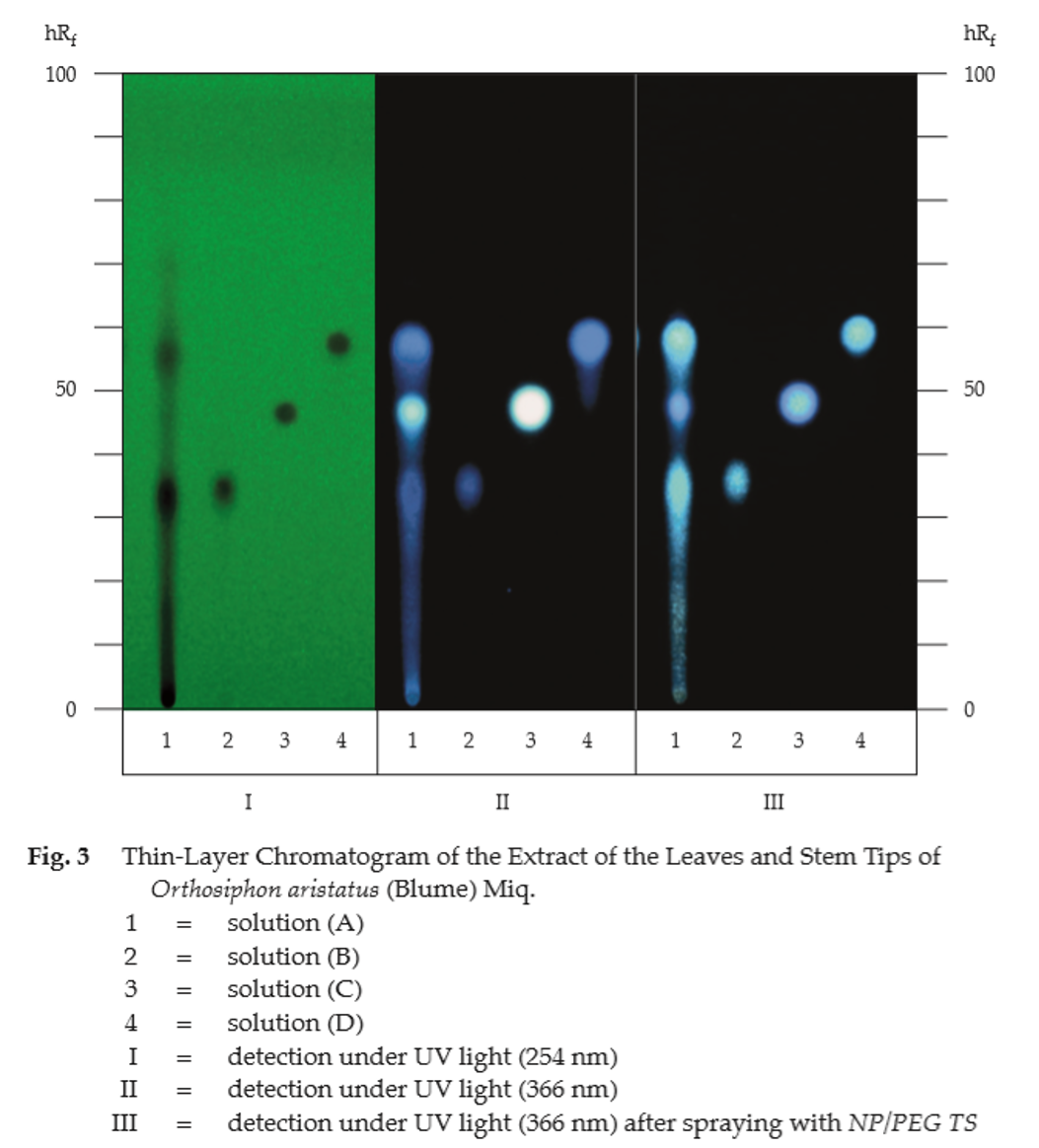ตำรามาตรฐานยาสมุนไพรไทย
Thai Herbal Pharmacopoeia
สำนักยาและวัตถุเสพติด กรมวิทยาศาสตร์การแพทย์ กระทรวงสาธารณสุข
Bureau of Drug and Narcotic, Department of Medical Sciences, Ministry of Public Health(Tinospora crispa (L.) Hook.f. & Thomson)
(Nelumbo nucifera Gaertn.)
(Centella asiatica (L.) Urb.)
(Centella Dry Extract)
(Centella Cream)
(Mesua ferrea L.)
(Piper sarmentosum Roxb.)
(Piper sarmentosum Roxb.)
(Pterocarpus santalinus L. f.)
(Santalum album L.)
(Senna tora (L.) Roxb.)
(Senna alata (L.) Roxb.)
(Senna Alata Tea)
(Piper retrofractum Vahl)
(Myristica fragrans Houtt)
(Andrographis paniculata (Burm. f.) Nees)
(Andrographis Capsules)
(Allium ascalonicum L.)
(Ocimum tenuiflorum L.)
(Curcuma longa L.)
(Turmeric Capsules)
(Turmeric Dry Extract)
(Turmeric Dry Extract Capsules)
(Arcangelisia flava (L.) Merr.)
(Curcuma sp.)
Harrisonia perforata (Blanco) Merr.
(Aristolochia pierrei Lecomte)
(Zingiber officinale Roscoe)
(Ginger Capsules)
(Ginger Tea)
(Cassia fistula L.)
(Nardostachys jatamansi (D. Don) DC.)
(Angelica sinensis (Oliv.) Diels)
Artemisia annua L.
(Ligusticum sinense Oliv. cv. Chuanxiong)
(Neopicrorhiza scrophulariiflora Pennell)
(Atractylodes lancea (Thunb.) DC.)
(Aucklandia lappa Decne)
(Terminalia chebula Retz.)
(Angelica dahurica (Hoffm.) Benth. & Hook. f. ex Franch. & Sav. var. dahurica)
(Kaempferia parviflora Wall. ex Baker)
(Hibiscus sabdariffa L.)
(Roselle Tea)
(Allium sativum L.)
(Zingiber zerumbet (L.) Sm.)
(Wurfbainia testacea (Ridl.) Škorničk.& A. D. Poulsen)
(Cannabis sativa L.)
(Myristica fragrans Houtt)
(Dracaena cochinchinensis (Lour.) S. C. Chen)
(Ficus racemosa L.)
(Hyptis suaveolens (L.) Poit.)
Clerodendrum indicum (L.) Kuntze
(Phyllanthus emblica L.)
(Citrus hystrix DC.)
(Citrus hystrix DC.)
(Areca catechu L.)
(Momordica charantia L.)
Moringa oleifera Lam.
(Aegle marmelos (L.) Corrêa)
(Solanum trilobatum L.)
(Morus alba L.)
Gynostemma pentaphyllum(Thunb.)
Makino
(Clinacanthus nutans (Burm. f.) Lindau)
(Cissus quadrangularis L.)
(Mimusops elengi L.)
(Zingiber montanum (J. König) Link. ex A. Dietr.)
(Piper betle L.)
(Capsicum annuum L.)
(Capsicum Oleoresin)
(Capsicum Gel)
(Piper nigrum L.)
(Piper nigrum L.)
(Eurycoma longifolia Jack)
(Thunbergia laurifolia Lindl.)
(Piper wallichii (Miq.) Hand.-Mazz.)
Senna garrettiana (Craib) H. S. Irwin & Barneby
(Terminalia bellirica (Gaertn.) Roxb.)
(Terminalia chebula Retz.)
(Caesalpinia bonduc (L.) H. Roxb.)
(Tarlmounia elliptica (DC.) H. Rob., S. C. Keeley, Skvaria & R. Chan)
(Hog Creeper Vine Dry Extract Capsiles)
(Hog Creeper Vine Dry Extract)
(Brachypterum scandens (Roxb.) Miq.)
(Lepidium sativum L.)
(Nigella sativa L.)
(Cuminum cyminum L.)
(Foeniculum vulgare Mill.)
(Plantago ovata Forssk.)
(Pimpinella anisum L.)
(Carum carvi L.)
(Anethum graveolens L.)
(Trachyspermum ammi (L.) Sprague)
Albizia procera (Roxb.) Benth.
(Acorus calamus L.)
(Tiliacora triandra (Colebr.) Diels)
Cyanthillium cinereum (L.) H. Rob.
(Orthosiphon aristatus (Blume) Miq.)
Murdannia loriformis (Hassk.) R. S. Rao & Kammathy
(Capparis micracantha DC.)
(Chrysopogon zizanioides (L.) Roberty)
(Cyperus rotundus L.)
(Cannabis sativa L.)
(Syzygium aromaticum (L.) Merr. & L. M. Perry)
(Boesenbergia rotunda (L.) Mansf.)
(Acanthus ebracteatus Vahl)
(Acanthus ilicifolius L.)
(Kaempferia galanga L.)
(Curcuma comosa Roxb.)
Betula alnoides Buch.-Ham. ex D. Don
Cannabis sativa L.
Carthamus tinctorius L
Mitragyna speciosa (Korth.) Havil
Mallotus repandus (Rottler) Müll. Arg
Azadirachta indica A. Juss. var. siamensis Valeton
Azadirachta indica A. Juss. var. siamensis Valeton
Punica granatum L.
Rhinacanthus nasutus (L.) Kurz
Baliospermum solanifolium (Burm.) Suresh
Curcuma aeruginosa Roxb
Boesenbergia kingii Mood & L. M. Prince
Senegalia rugata (Lam.) Britton & Rose
Acacia concinna (Willd.) DC.
Senegalia rugata (Lam.) Britton & Rose
Acacia concinna (Willd.) DC.
Senna alexandriana Mill. var. alexandriana
Cassia acutifolia Delile, Cassia angustifolia Vahl
Butea superba Roxb. ex Willd.
[Plaso superba (Roxb. ex Willd.) Kuntze, Rudolphia superba (Roxb. ex Willd.) Poir.
Pueraria candollei Graham
ex Benth. var. mirifica (Airy Shaw & Suvat.) Niyomdham
Streblus asper Lour.
Suregada multiflora (A. Juss.) Baill. (Gelonium
multiflorum A. Juss.
Plumbago zeylanica L.
Plumbago indica L.
Biancaea sappan (L.) Tod.
Ziziphus attopensis Pierre
Streblus asper Lour.
Justicia gendarussa Burm. f.
Enhalus acoroides (L. f.) Royle
Bridelia ovata Decne.
Tamarindus indica L.
Citrus × aurantiifolia (Christm.) Swingle
Garcinia mangostana L.
Blumea balsamifera (L.) DC
Persicaria odorata (Lour.) Soják
Zingiber montanum (J. König) Link ex A. Dietr.
Mammea siamensis (Miq.) T. Anderson
Citrus maxima (Burm.) Merr.
Citrus × aurantium L. ‘Som Sa’
Punica granatum L.
Rhinacanthus nasutus (L.) Kurz
Java Tea is the dried leaf and stem tip of Orthosiphon aristatus (Blume) Miq. [O. spicatus (Thunb.) Backer, Bakh. f. & Steenis, O. stamineus Benth.] (Family Labiatae), Herbarium Specimen Number: DMSC 1738, Crude Drug Number: DMSc 398. (Note Java Tea should be harvested shortly before the flowering period.)
Constituents Java Tea contains terpenoids (e.g., ursolic acid), caffeic acid and its derivatives (e.g., rosmarinic acid) and flavones (e.g., sinensetin). It also contains volatile oil, potassium, etc.
Description of the plant (Figs. 1a, 1b) Perennial herb up to 2 m tall, usually branched at base; stem quadrangular, covered with short hairs. Leaves simple, opposite, ovate, or ovatelanceolate, 1.5 to 10 cm long, 1 to 5 cm wide, apex acuminate, base cuneate, margin coarsely serrate from about the middle upwards, minutely hairy on the nerves or glabrous, glandular punctate beneath; petiole up to 3 cm long. Flowers arranged in whorl, distantly along an elongated rachis, terminal, 7 to 30 cm long, white to violet; pedicel hairy, 1 to 6 mm long; calyx campanulate, 2.5 to 4.5 mm long (to 10 mm in fruit), curved, with longitudinal veins, 2-lipped, the upper lip broad, the lower 4-teethed; corolla much longer than calyx, about 3 cm long, the tube slender, 1 to 1.8 cm long, straight, 2-lipped, upper lip shallowly 4-lobed, recurved, the lower straight, concave; stamens 4, in 2 pairs, filament glabrous, filiform, very long, anther 2-celled; the tip of the style club-shaped. Fruit 4 nutlets; nutlet ovoid-oblong, about 2 mm long, rather flattened, rugose.
Description Odour, slightly aromatic; taste, somewhat bitter and salty, later as tringent.
Macroscopical (Figs. 1a) A mixture of entire and broken, crisp, mainly dark green ovate or ovate-lanceolate leaves and quadrangular stems with a deep longitudinal groove down two opposite sides.
Microscopical (Figs. 2a, 2b, 2c, 2d) Transverse section of the leaf through the midrib and surface view of the lamina show upper epidermis, a single layer of rectangular cells covered with thick cuticle, wavy-walled in surface view; diacytic and anomocytic stomata; covering trichome, unicellular or multicellular, up to 6 cells, non-stalk glandular and unicellular-stalk glandular radiated head with 4 cells or more; mesophyll, a layer of columnar palisade cells and several layers of spongy parenchyma; vascular bundle collateral; collenchyma occuring in the midrib, beneath upper and lower epidermises; lower epidermis, a single layer of rectangular cells covered with thick cuticle, wavy-walled in surface view; diacytic and anomocytic stomata; covering trichomes similar to those of upper epidermis.
Transverse section of the stem shows epidermal cells polygonal to elongated in surface view with scattered anomocytic and diacytic stomata; covering trichome multicellular, multicellular glandular trichome, unicellular, non-stalk similar to those of the leaf; underlying groups of collenchyma in the ridge; endodermis, small parenchyma cells associated with fibre group.Vascular bundle, phloem and xylem; vessel, spiral, scalariform, reticulate and pitted. Pith, thin-walled and polygonal large parenchyma cells.
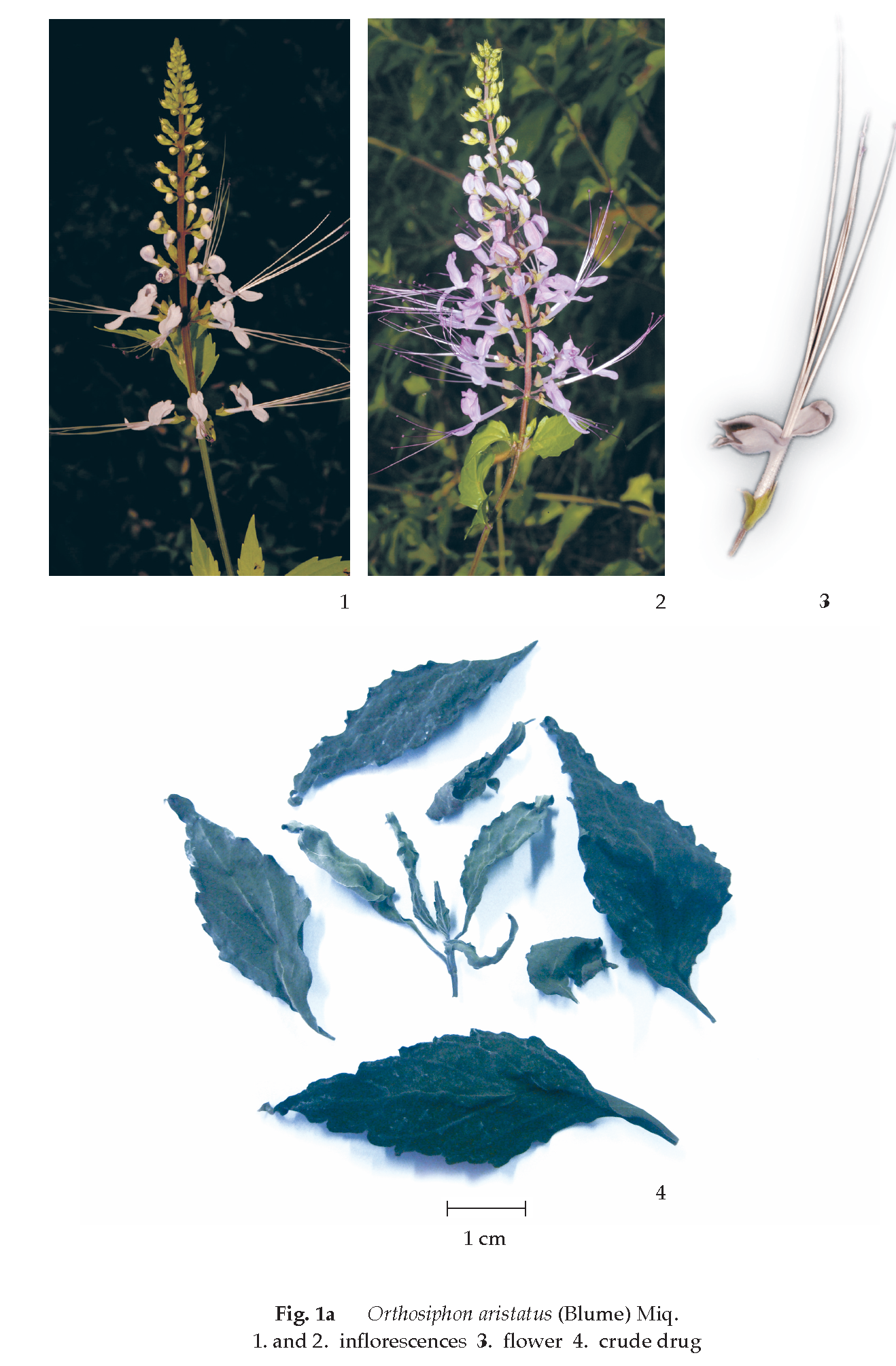
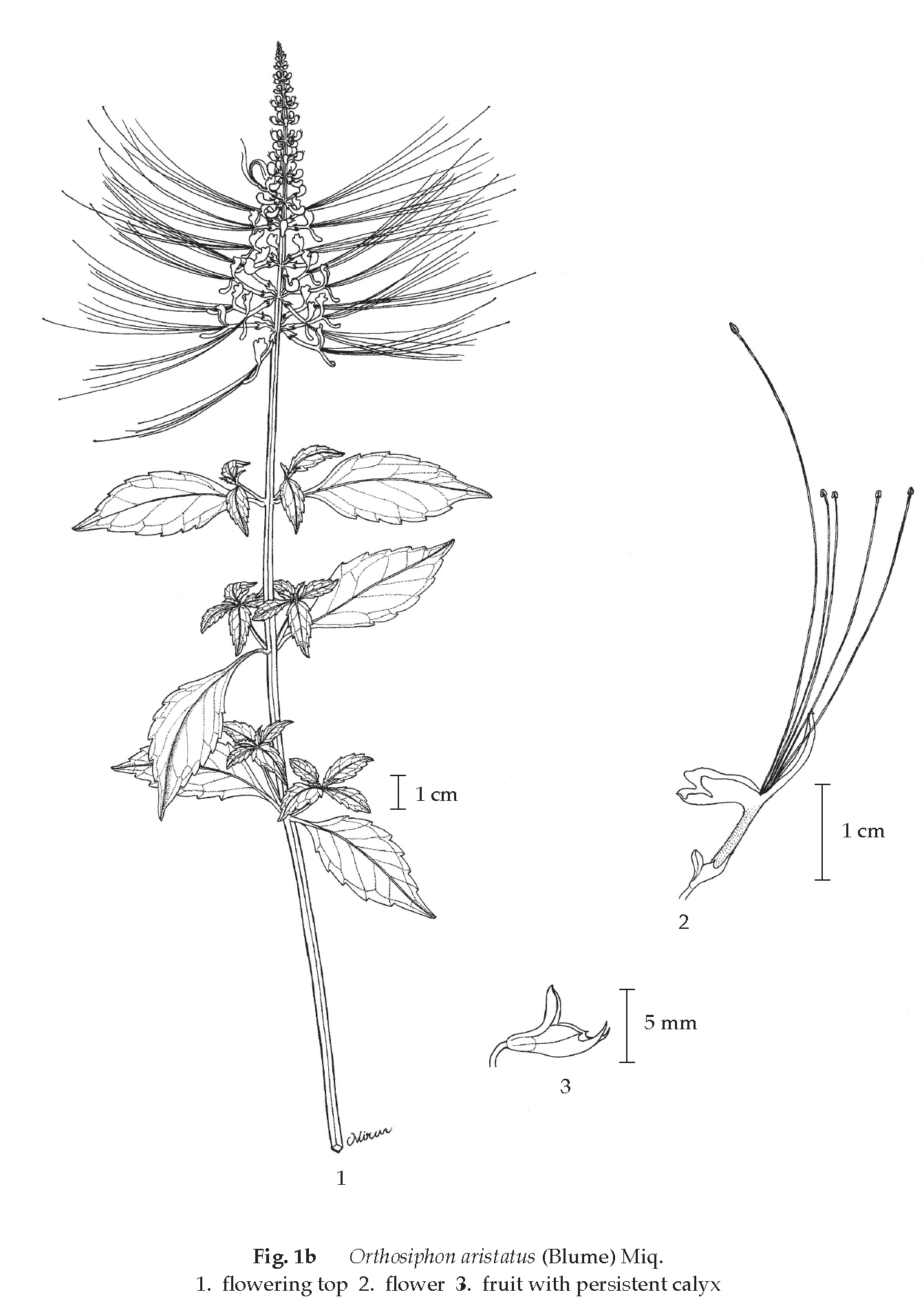
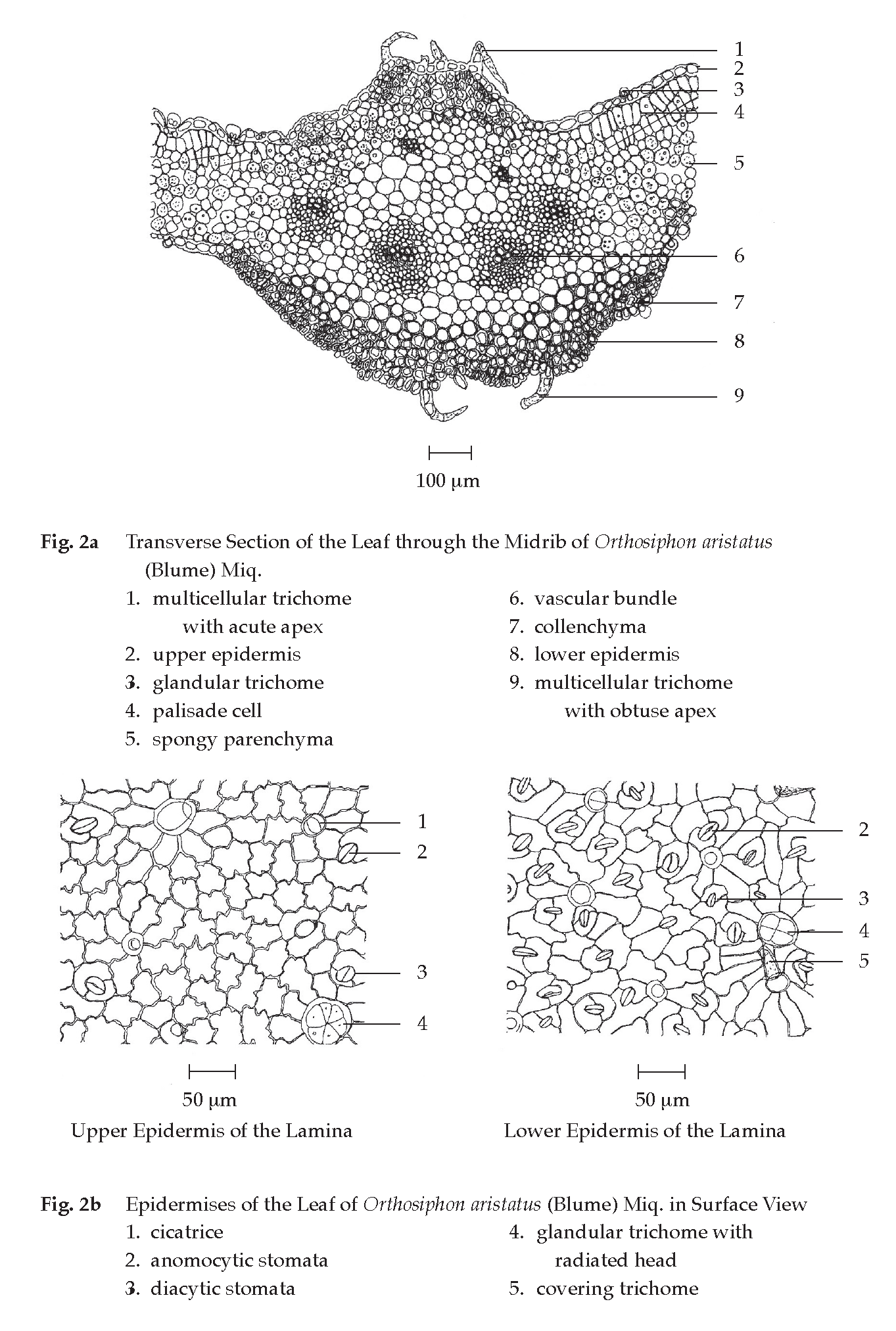
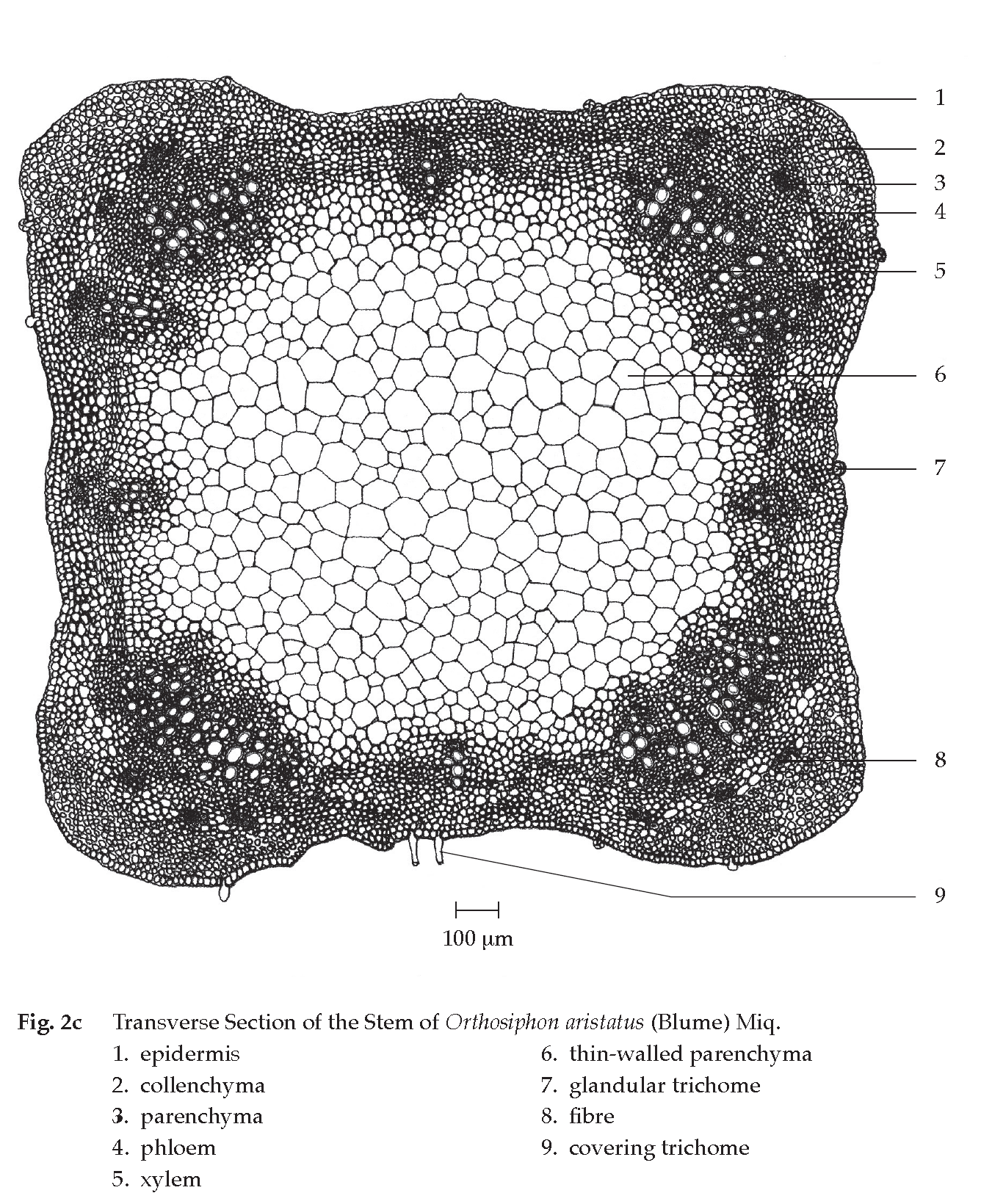
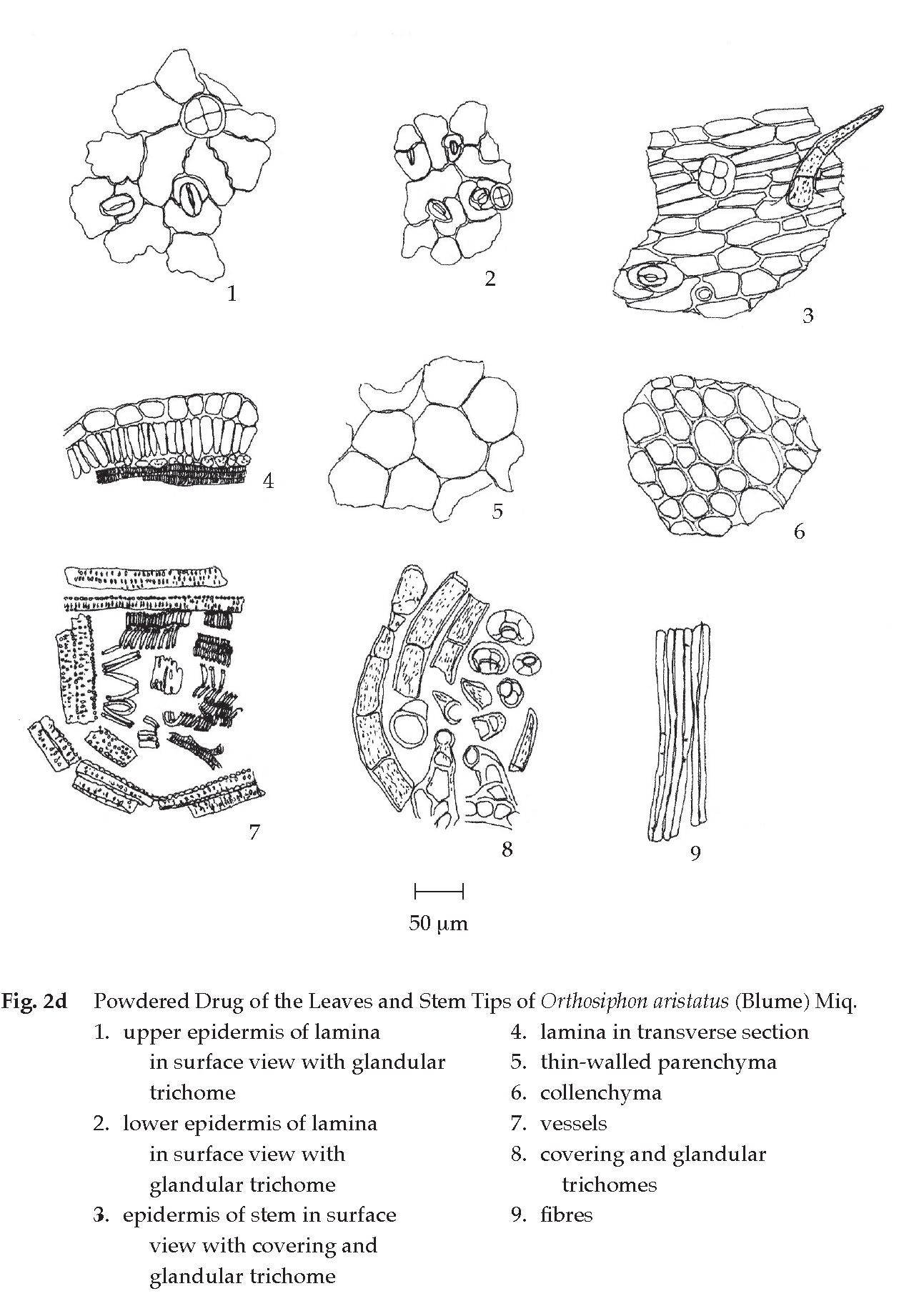
Java Tea in powder possesses the diagnostic microscopical characters of the unground drug.
Contra-indication It is contra-indicated in patients with impaired cardiac and/or renal function.
Storage Java Tea shall be stored in a dry place, protected from light.
Identification
A. Reflux 1 g of the sample, in fine powder, with 50 mL of water for 30 minutes, filter and evaporate the filtrate to 25 mL (solution 1). To 2 mL of solution 1, add a few drops of 0.02 M potassium permanganate and shake well: the colour of permanganate solution disappears.
B. To 1 mL of solution 1, add a few drops of a 1 per cent w/v solution of iron(III) chloride: a greyish green colour develops.
C. Evaporate 0.5 mL of solution 1 to dryness, moisten the residue with 1 drop of 6 M hydrochloric acid: it imparts a reddish violet colour to a non-luminous flame.
D. Carry out the test as described in the “Thin-Layer Chromatography” (Appendix 3.1), using silica gel GF254 as the coating substance and a mixture of 45 volumes of toluene, 45 volumes of ethyl acetate and 5 volumes of formic acid as the mobile phase and allowing the solvent front to ascend 10 cm above the line of application. Apply separately to the plate, 5 μL of solution (A), 3 μL of solution (B), 1 μL of solution (C), and 2 μL of solution (D). Prepare solution (A) by evaporating 20 mL of solution 1 to dryness. Reflux the residue with 25 mL of methanol for 10 minutes, filter and evaporate the filtrate to dryness. Dissolve the residue in 5 mL of a 50 per cent v/v solution of methanol. For solution (B), dissolve 400 μg of rosmarinic acid in 1 mL of methanol. For solution (C), dissolve 1 mg of sinensetin in 20 mL of methanol. For solution (D), dissolve 200 μg of caffeic acid in 1 mL of methanol. After removal of the plate, allow it to dry in air and examine under ultraviolet light (254 nm), marking the quenching spots. The chromatogram obtained from solution (A) shows three quenching spots (hRf values 30 to 37, 44 to 48 and 52 to 60) corresponding to rosmarinic acid, sinensetin and caffeic acid spots from solutions (B), (C) and (D), respectively. Examine the same plate under ultraviolet light (366 nm), three blue fluorescent spots corresponding to rosmarinic acid, sinensetin, and caffeic acid are observed.Heat the plate at 80° for at least 10 minutes and then spray with natural products (NP) TS while the plate is still warm. Subsequently spray the plate with polyethyleneglycol (PEG) TS and observe the colours of the spots under ultraviolet light (366 nm) within 5 to 15 minutes; the spots due to rosmarinic acid, sinensetin and caffeic acid are blue fluorescent. Another spot of lower hRf value appears also as a blue fluorescent spot (Table 1); see also Fig. 3.
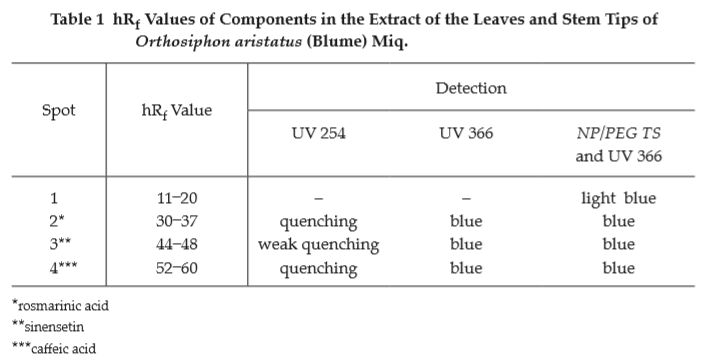
Loss on drying Not more than 11.0 per cent w/w after drying at 105° for 5 hours (Appendix 4.15).
Foreign matter Not more than 5 per cent w/w of dried stems with a diameter greater than 2 mm; not more than 2 per cent w/w of other foreign matter (Appendix 7.2).
Acid-insoluble ash Not more than 1.0 per cent w/w (Appendix 7.6).
Total ash Not more than 12.5 per cent w/w (Appendix 7.7).
Ethanol-soluble extractive Not less than 10.0 per cent w/w (Appendix 7.12).
Water-soluble extractive Not less than 20.0 per cent w/w (Appendix 7.12).
Dose 2 to 4 g, prepared as an infusion by soaking dried material with 150 mL of boiling water for 5 to 20 minutes, two to three times a day before meals.
